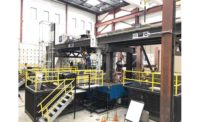...the Hyogo Earthquake Engineering Research Center in Miki City, Japan, the frame drifted a maximum of 3.8% and returned to its plumb position.
The system is intentionally designed to use standard construction materials and practices to minimize extra costs. “I would put the premium at less than 1% of the building cost,” says Gregory P. Luth, president of the Santa Clara, Calif., firm that bears his name and a collaborator on the research project.
The engineer used a variation of the rocking-frame-fuse concept on a concrete shear-wall frame at the University of Southern California School of Cinema. The USC system priced out during preconstruction at $1 million more than a conventional moment frame, and the contractor said it would take six months longer to build, says Luth. “In reality, the system was built faster than a conventional moment frame because of the erection sequence developed as part of the design, and it was under budget,” he adds.
The example does not satisfy at least one seismic engineer, who, though supporting the research, likens the system to a “Swiss watch,” with fussy detailing and fabrication required of some parts. “This is likely to impede its adoption,” says Ronald O. Hamburger, a senior principal in the San Francisco office of Simpson Gumpertz & Heger.
Deierlein says that with careful, full connection detailing by the engineer and proper education of the steel fabricator—admittedly unaccustomed to post-tensioning—the system can work. “The engineer must fully detail these connections,” he says.

Deierlein and others point out that though the structure would not be damaged, other parts of the building would, including cladding, ceilings, partitions and more. But nonstructural damage is simpler to repair, says the researcher. If a building is red-tagged after a quake, it must undergo a structural inspection before it can be repaired and re-occupied. That could take many months to complete, he says.
Some engineers argue that because strong earthquakes are relatively rare occurrences and the “design life” of most buildings is only about 50 years, most buildings will never experience strong shaking. Consequently, “most developers are reluctant to spend much money to incorporate a high-performance system as the cost can often outweigh the probably avoided losses,” says Hamburger.
But Hamburger admits “the quest for damage-tolerant or damage-immune systems is clearly the Holy Grail of earthquake engineering” and that this type of research is important.



















Post a comment to this article
Report Abusive Comment